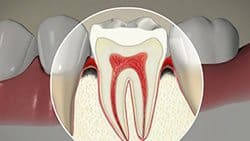Brief Summary
The root canal is a dental treatment that has extraordinary benefits. With proper anesthetics, a dentist can painlessly remove the infected pulp from your tooth to prevent further decay. This will save the tooth from needing to be removed. It is a practice that is safe and proven to show long-lasting results.
What Is Pulp?
Understanding terminology is a great way to increase awareness!
The term dental pulp refers to the contents that are found inside of the tooth. This is a non-mineralized oral tissue with a gelatinous texture. It has properties that connect nervous, vascular and lymphatic systems together. The pulp provides sensory function and effective blood flow that helps nourish the teeth. Furthermore, pulp aids in the production of dentin which is the layer underneath the enamel (surface of the tooth) that provides the incredible strength teeth are known for.

Common Causes Of Damaged Pulp
There are multiple causes for damaged pulp, but regardless of what the cause is, when it’s infected or diseased, it must be removed no matter what. Further damage at this level can be far worse for the patient’s health. Typically, the causes that are most common are:
- A chip or cracked tooth
- Deep cavities that have gone past the enamel
- Traumatic injuries
Whenever cases such as these occur, the potential for bacteria growth makes the pulp very susceptible to infection. At this point, a root canal has to be carried out because the infection cannot be allowed to spread.
The Process
The basic outline of the operation, for more information, contact us!
- To begin the procedure, we will administer local anesthetics to ensure that the operation is as pain-free as possible. Next, we will prepare the area for the surgery. That will consist of placing a thin sheet over the teeth that aren’t in question to isolate the focal point.
- Next, there is an incision that makes an opening through the crown (surface) of the tooth to gain access into the pulp chamber.
- Once the pulp is reached, it will be carefully removed from the pulp chamber and cleared from the canals of the root. This will ensure that the spread of infection is halted.
- It is also possible that an antibacterial medication may be placed into the pulp chamber to facilitate a cleanse. This is administered by the attending dentist if deemed necessary for the operation. After this, the pulp chamber is then refilled with nature cement-like substance to imitate the pulp.
- Now that the site has been removed from infectious material, your dentist will place temporary fillings on the opened area of the crown. This prevents saliva from being allowed into the vulnerable area.
- After that is allowed to settle, we can then remove the temporary filling and replace it with a permanent crown/filling made of a sturdier material. This is either made of porcelain or metal allow for strength and appearances.
It is very important to follow your dentist’s directions regarding the scheduling of your dental appointment so that your root canal treatment will be successful.
How Long Will It Last?
The process should not last more than a few hours at the most. Depending on time constraints it can be spread out over a few days if need be. You will still be able to use your teeth even with a root canal as if it were a natural tooth. That is the great aspect of root canals that make them so beneficial. After the operation, you can resume eating and drinking as normal!
We’ll Be Happy To Help!
Your dentist will assist you with this decision. If this is something you are interested in but don’t know if you can afford, check out our financing option. Here at Marquette Dentistry, we believe that everyone should have the ability to have the smile they have always wanted.

Remember, good daily cleaning habits and regular dental exams will help you keep and maintain your teeth.

